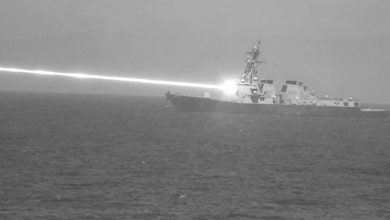Report: China eyes guided-missile capabilities akin to US, Russian submarines

China has launched its first nuclear-powered guided missile submarines, giving it the ability to launch land and sea attacks that were previously limited to U.S. and Russian vessels, the latest Pentagon report on China’s military indicated.
The Pentagon report, published Oct. 20, marks the first apparent confirmation that modified submarines seen in Chinese shipyards over the last 18 months are Type 093B guided missile submarines.
Reuters revealed in May 2022 that satellite images from the Huludao shipyard in northeast China showed a new or upgraded class of submarine, possibly with vertical tubes for launching cruise missiles.
The Pentagon report says that in the short term, the Chinese navy “will have the ability to conduct long-range precision strikes against land targets from its submarine and surface combatants using land-attack cruise missiles, notably enhancing (China’s) power projection capability.”
Known as SSGNs, conventionally armed missile submarines were developed by the Soviet Union during the Cold War in part to target U.S. aircraft carriers, while the U.S. Navy developed its own version by converting ballistic missile boats to carry large numbers of land-attack Tomahawk cruise missiles.
Cruise missiles are typically long-range, precision weapons that, unlike ballistic weapons, fly at low altitudes or skim the surface of the sea.
The submarine USS Florida fired 93 Tomahawks against Libyan air defenses in 2011 – the first combat strikes from a U.S. SSGN and an event that regional military attaches say was closely studied by Chinese strategists.
Some analysts say the PLA navy will be eager to deploy the vessels as an extra weapon against aircraft carriers as well as a land-attack platform, allowing strikes from a far greater range than its fleets of smaller attack submarines.
The report notes that three of the new SSGNs could be operational by next year, as part of a wider expansion of its submarine fleet – both nuclear and diesel-powered – which could number 65 vessels in 2025.
The Chinese defense ministry did not respond to questions from Reuters.
The confirmation comes amid an intensifying submarine arms race as China constructs a new generation of nuclear-armed boats as part of its evolving deterrent force.
The effort to track China’s submarines at sea is one of the core drivers of increased deployments and contingency planning by the U.S. Navy and other militaries across the Indo-Pacific region.
Singapore-based security scholar Collin Koh said the SSGNs were an important new capability for the Chinese navy.
With an expected core armament of cruise missiles, “this potentially allows them to carry out saturated land and anti-ship attacks at standoff range,” he said, which would complicate strategic calculations by China’s rivals.
“I would also expect the Chinese to have learned from the Russian experience in using them to threaten U.S. aircraft carriers – with an SSGN, you can launch strikes at standoff range, unlike a typical attack submarine that could have more limited weapon options, and that is a real advantage,” said Koh, of the S. Rajaratnam School of International Studies.
The research discussed at the U.S. Naval War College in May noted that the PLA was close to breakthroughs in making its nuclear-powered submarines far quieter and more difficult for the U.S. and its allies to track.
Some diplomats and analysts said, however, that it was unclear whether those breakthroughs had been incorporated into the recently launched SSGNs. The upgrades are expected in nuclear-powered boats launched before the end of the decade.
“Unless they are certain of improvements, we can expect the PLA navy to be cautious in how they initially deploy them,” said an Asian military attache who is tracking China’s submarine force. The attache declined to be named because of the sensitivity of the matter. “But we know the submarine force is a priority for Xi Jinping, and this is one more sign they are getting there.”





